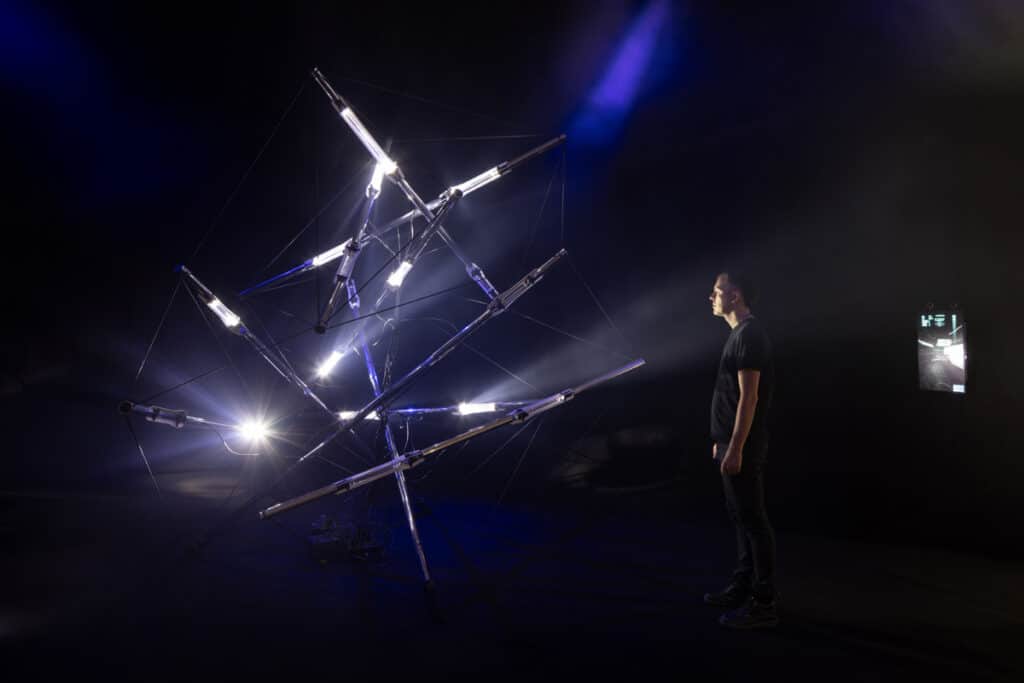Moritz Simon Geist. Juried Artist
SAE
Artist Statement
The algo-kinetic work “Don’t look at me” is designed as an organism, reflecting on topics attention economics, sound and movement. Attention has emerged as the primary metric in social media, and most of their algorithms are designed to harness and shape human attention, trying to keep the users on their platform, leading to severe real-world consequences. The organism is designed to have an anti-social media algorithm: The more attention it senses, the more stressed and disharmonic the entity becomes. If there is only one human present the entity is relaxed, emitting harmonic sounds and slow movements.
Central to the installation are the newly developed robotic actuators, consisting of resonator tubes and vibrato elements (vibraphone-principle). These actuators physically generate sine waves, drawing inspiration from the avant-garde acoustic designs of Harry Partch. Visually, the work is referencing the tensegrity principle, introduced by Buckminster Fuller and Kenneth Snelson. The actuators are positioned within this 2,5m x 2,5m moving tensegrity structure, offering an spatial experience for the humans around it.
The algo-kinetic work “Don’t look at me” is designed as an organism, reflecting on the economics of attention, sound and movement. Attention has emerged as the primary metric in social media, and most of their algorithms are designed to harness and shape human attention, trying to keep the users on their platform. The organism is designed to have an anti-social media algorithm: The more attention it senses, the more stressed and disharmonic the entity becomes. If there is only one human present the entity is relaxed, emitting harmonic sounds and slow movements.
Central to the installation are the newly developed robotic actuators, consisting of resonator tubes and vibrato elements (vibraphone-principle). These actuators physically generate sine waves. Visually, the work is referencing the tensegrity principle (Fuller / Snelson). The actuators are positioned within a 2,5m x 2,5m moving tensegrity structure.
The work explores the connection to ‘place’, the idea that all times coexist in a given location, with its algorithm reacting on past present and future behaviors in its surroundings. The work resonates with the role of art and creation in the Everywhen – being not an isolated piece of work but a process of timely connection – referencing to past concepts like the vibraphone or the tensegrity, and more broadly a dialogue between humans and technology.
About the artists
Moritz Simon Geist is a music producer and artist based in Dresden, Germany. After studying mechanical engineering, he pursued a music career internationally. He works with robots to create electronic music. He debuted with the mechanical drum robot “MR-808” in 2012 and has since explored the sound making and producing of electronic music with robots and mechanics. His compositions are influenced by various electronic music styles as well as classical music. Geist has worked with artists such as Mouse On Mars, Tyondai Braxton, or Robert Lippok and has showcased his works and performances at several hundred occasions since 2012 such as the the Venice Biennale (Italy), the South By Southwest Festival, Teh Philharmonie de Paris, the Elbphilharmonie Hamburg or ZER01NE South Korea. From 2017 – 2020 he held a master class at the NYU Berlin. The Rolling Stone Magazine listed him as one of the “10 Great Musical Discoveries” SXSW 2019. He was awarded numerous awards, like the German Pop Music Price 2022 (Lower Saxony), the Working Grant ZER01NE in Seoul 2023 or the VIA VUT Award 2019.
Credits: Moritz Simon Geist, ZER01NE

